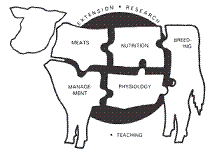Animal Science, Department of

Nebraska Beef Cattle Reports
Date of this Version
2020
Citation
The Board Regents of the University of Nebraska. All rights reserved.
Abstract
Crossbred steers (n=270; 645 lb, ± 3 lb) were used in a 2 × 3 factorial treatment design in a growing (54 d) and finishing study (130 d). Th e factors were 0 or 44% sugar beets (dry matter basis) in place of dry rolled corn, during the growing phase and 0, 15, or 30% sugar beets during the finishing phase. Daily gain was not different for the growing treatments but the calves on the 44% sugar beet treatment had less dry matter intake than those on the 0% sugar beet treatment, making them 5.5% more efficient. However, during the finishing phase, the steers on the 0% sugar beet treatment had greater daily gain than those on the 44% sugar beet treatment. Related to the beet inclusion during finishing, the 0% sugar beet treatment and the 15% had similar gain and feed efficiency, which was greater than the 30% sugar beet treatment. Hot carcass weight, back fat, and yield grade were greatest for the 0%, followed by 15%, and with 30% sugar beets having the least. Including sugar beets in a growing ration could increase feed efficiency by decreasing dry matter intake with similar gain. Including sugar beets in a finishing diet will likely not result in similar performance or carcass characteristics to a dry- rolled corn based diet.
Included in
Large or Food Animal and Equine Medicine Commons, Meat Science Commons, Veterinary Preventive Medicine, Epidemiology, and Public Health Commons


Comments
2020 Nebraska Beef Cattle Report